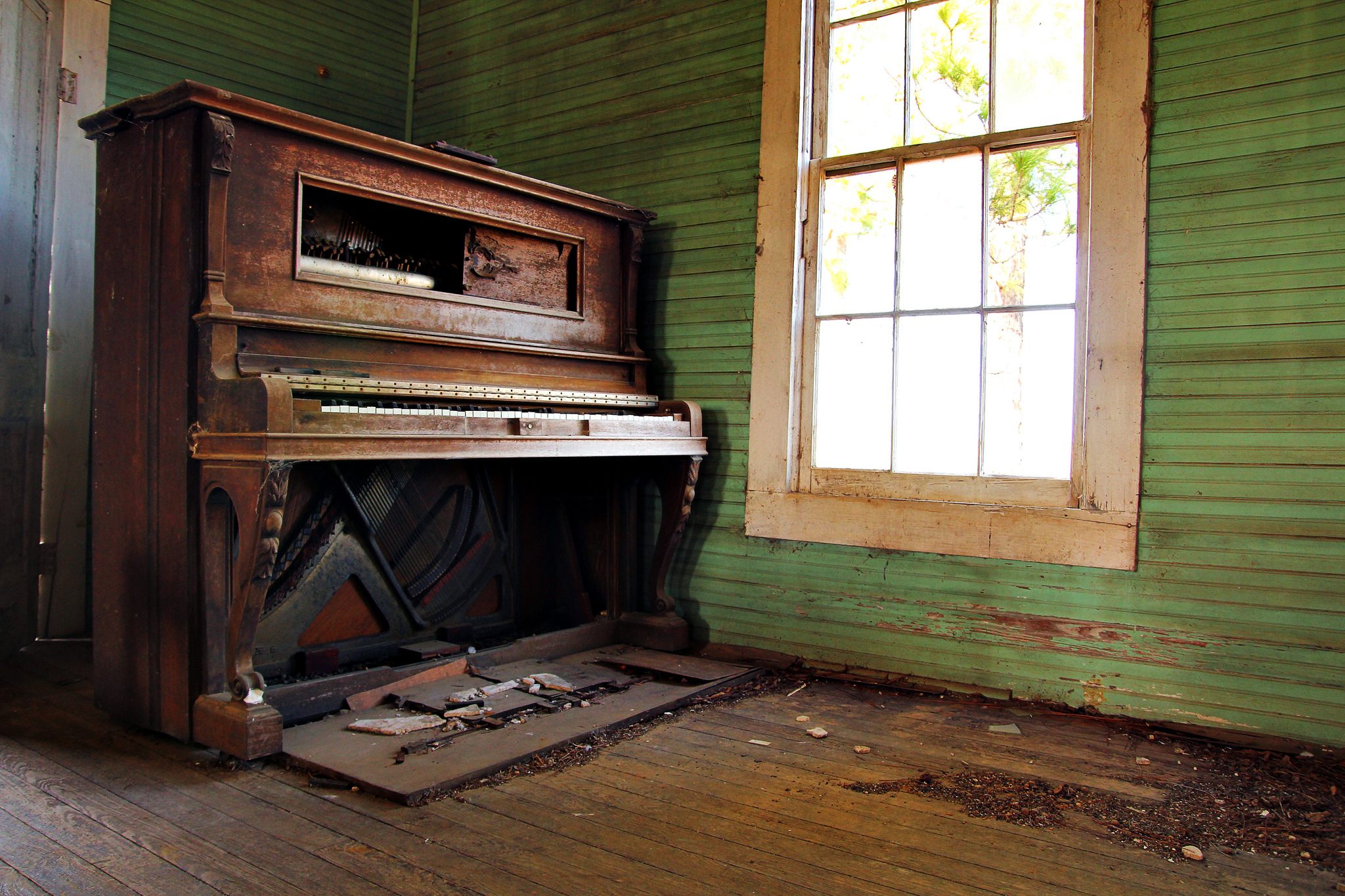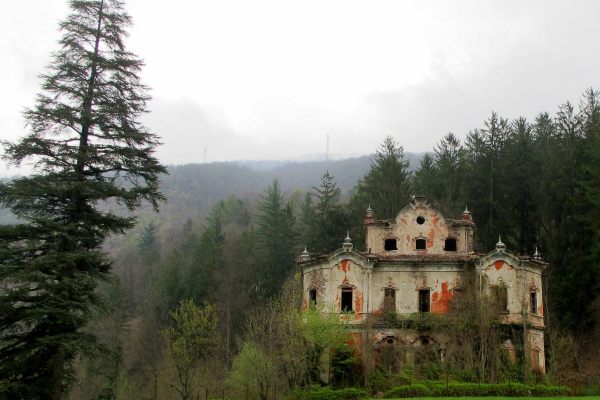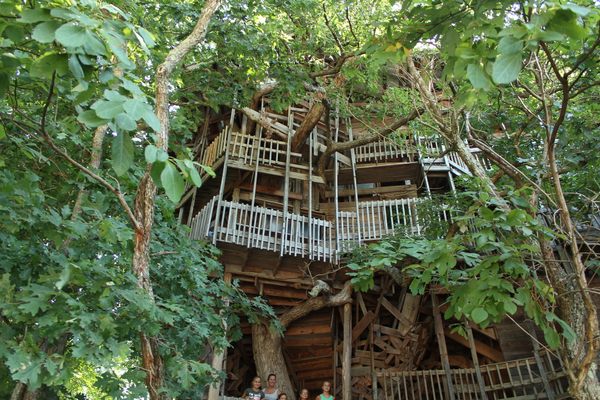The Photographer Who is Getting Inside Abandoned Rural America

The abandoned Island Grove Methodist Church, built circa 1885 in North Florida. (Photo: Kelly Micheau)
Photographer Kelly Micheau started out as, in her words, an “armchair explorer.” After watching a documentary about Paris’ famous catacombs about five years ago, she began scouring the internet for stories of old, abandoned places. Eventually, she got the urge to hit the road and started mounting her own expeditions in and around north Florida. The Far Enough Photo project, which documents the decaying 19th-century structures she stumbles upon, was born.
Urban exploration (or “urbex”) is a popular term for the scoping out of old buildings, but Micheau’s pursuit is a bit more specific. Her niche, she says, is “in the homes, churches, and schools of the rural South, referred to as ‘rurex’ until someone coins a better term!”
In addition to finding and photographing these abandoned buildings around North Florida, Georgia, and Alabama, Micheau researches their history in great detail. She answered questions about her project via email.

Inside an abandoned Methodist church, built circa the 1870s in south Georgia. (Photo: Kelly Micheau)
Atlas Obscura: What is it about abandoned and historic buildings that fascinates you?
Kelly Micheau: How could they not be fascinating?!
Remnants of another time, left to rot in this one. Like memorials to their builders’ hopes and intentions, these places represent so much more than just four decaying walls.
I enjoy the peek into what life was like for someone from a different time.

An abandoned Presbyterian church in southwest Alabama. (Photo: Kelly Micheau)
How do you find the structures you document? Once you’ve located them, how do you decide to go inside? Do you ever take mementoes?
The process of finding these places can be tedious, but is also part of the fun.
Sometimes I know of an exact building that I have seen previously documented and I will spend hours, days—or, in one case, two years—trying to find it for myself. This generally involves lots of Googling, hunting through Flickr, digging through archived old images, and scanning satellite images looking for the needle in a haystack!
But If I don’t have a specific structure in mind, I usually find them by good old-fashioned wandering. I avoid highways like the plague and I almost always refuse to take the same way home.

An abandoned home in North Florida. (Photo: Kelly Micheau)
Ideally, I would have the chance to see inside each of them, but realistically, its just not always possible. I respect “No Trespassing” signs, I don’t break windows, and I don’t pick locks. If a structure appears reasonably safe for entry (like the roof isn’t going to collapse and the floors aren’t falling in) and I can find an open entry, I generally go for it. With all that being said, I will first exhaust every opportunity I have to get permission. I won’t hesitate to knock on a neighbor’s door, visit the local gas station to ask locals for information, and in many cases handwriting letters I’ve mailed to the property owners.
As curious as I might be to see the inside of a location, I am just as concerned with respect to the place’s original builders and current property owners. Just because a structure is abandoned does not mean that someone somewhere doesn’t own it. The building and its contents are not mine to do with whatever I want, regardless of the fact that many seem to think so.

An abandoned boarding home for railroad workers in North Florida, built circa the early 20th century. (Photo: Kelly Micheau)
Is there a fine line between an explorer and a trespasser? How do you decide where that line is?
In my mind, I would like to think that there is a difference between explorer and trespasser, but I would be lying to myself. Legally speaking, if you are on any private property without permission, you are trespassing. It’s not as if the rules don’t apply to me, just because I have a camera in my hand. I just have to be okay with the consequences.
Many of these buildings are beginning to decay. Do you ever feel unsafe? Have you had any close calls?
Most of these buildings are already in advanced stages of decay, so safety concerns are always something I need to consider. I often feel concerned about the structural integrity of these places, and although I’m pretty brave, I’m not reckless. Paying close attention to buckling floorboards, leaning walls, and caving ceilings is obviously important. Because I’m careful in this regard, I haven’t had any close calls with building safety, per se.

A worker’s boot, left behind in a rural Georgian farmhouse built circa the 1870s on a cotton field. (Photo: Kelly Micheau)
Once you’ve documented a house, you do historical research into the house’s history. How do you conduct your research? What are some of the most interesting histories you’ve uncovered? Do you have a favorite?
Ah, the research! Like hunting for places, this can be tedious, too, but adds so much more to the experience for me, and hopefully my readers as well. My starting point is almost always on the county property appraisers’ site, where I will use a physical address (or the closest one I know) to track down the property owner’s name. Often with historic homesteads, the property will still be in the same family and I can track how it has changed hands from one member to another, often ending up in trust. From there, I will scour the internet for information on the family through local historic sites, genealogy forums and so on. I can follow a family’s movement through census records and, any time I can, I try to track down descendants who may still be in the area and willing to share history with me.

Inside an abandoned home in Georgia. (Photo: Kelly Micheau)
Each place has a unique history to uncover and I feel just as compelled to find out about the modest shack that housed tenant farmers as I do the grand plantation estates. Because of the time frame that I focus on (early 1800s to early 1900s) each home had many people who took their first and last breaths inside. I am acutely aware of this when I get to visit a place that undoubtedly has incredible history to one family somewhere.
In their own ways, each property grabs my interest and becomes like a pet project to me until I have uncovered all that can be uncovered. Whichever I am currently researching tends to be my favorite.

A military jacket inside an abandoned home in North Florida. (Photo: Kelly Micheau)
What’s the strangest or most surprising artifact/structure you’ve come across?
Often the buildings I find are empty, having been cleaned up by the owners, or scrapped and looted. But about 20 percent of the time, I will find mementos and artifacts left by the original owners. And in more instances than you might imagine, I find homes that are completely full with the material possessions of someone who stood where I am standing. Clothes in the closet, photos on the mantel, dishes in the sink, as if something so drastic and so immediate happened that it stopped time in this space.
The most surprising artifacts I have found are written letters that have been left behind. Very personal communications between loved ones when things had to be written down and sent by post. Important messages that, today, I cannot imagine taking days to arrive. Messages that, as I read now, I am offered a most intimate glimpse into the past.

Old technology on an abandoned porch in Georgia. (Photo: Kelly Micheau)
Are you a homeowner? If so, do you wonder about what will happen to your home in 100 years? If you aren’t a homeowner but hope to be some day, will you live in an old house?
I am a homeowner and I often think about the structures where I live and work and what will become of them. Will some random woman being touring my decaying home one day, wondering about who I was or why I left? Snooping around my remnants, calling it curiosity and research?
This project began as an opportunity for me to see and interact with the past, but also provides a chance to see what’s to come. What our places look like when we’re gone. It’s like having a rewind and fast-forward button.

Letters left in an abandoned home built circa the 1890s in North Florida. (Photo: Kelly Micheau)
What tips would you give to anyone who is interested in exploring old buildings?
Exploring should be just that. Get out there, drive, and find stuff for yourself.
Slow down. Open your eyes. Be safe. Be respectful. Take photos. Get to know the world around you.
See many more images from the Far Enough Photo project on Flickr and at Kelly Micheau’s website.





















Follow us on Twitter to get the latest on the world's hidden wonders.
Like us on Facebook to get the latest on the world's hidden wonders.
Follow us on Twitter Like us on Facebook